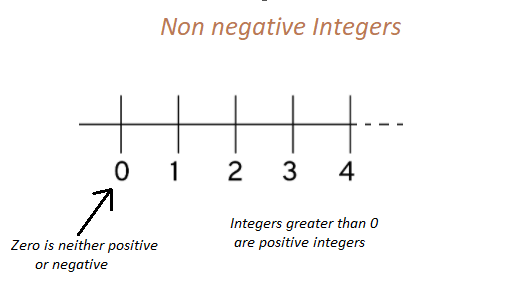The set of positive integers and zero are collectively called non-negative integers.

The set of integers denoted by Z consists of,
Z = {….,-3,-2,-1,0,1,2,3,…..} from which on removing the negative numbers we obtain the set of non-negative integers.
Non- negative integers and whole numbers:
The collection of all positive integers like 1, 2, 3,…. is known as the set of natural numbers. It is denoted by the letter N.
The set of natural numbers along with 0 is called the set of whole numbers. It is denoted by the letter W. So we see that the set of non-negative integers is the same as the set of whole numbers.
Therefore, Non-negative integers = W = N U {0}
Examples:
- -3 is not a non-negative integer (It is in fact negative although it is an integer).
- 3.5 is not a non-negative integer (It is positive but not an integer since it is a non-trivial decimal fraction).
- -3.5 is not a non-negative integer (It is neither positive nor an integer).
- 5 and 0 are examples of non-negative integers.
Why are non-negative integers so called?
Non-negative integers are so called because they are obtained by removing the negative numbers from the set of integers.
Is 0 a positive integer?
The number 0 is considered to be neither a positive nor a negative integer. It belongs to the set of non-negative integers.
What is the largest non-negative integer?
The numbers which are to the right of the number line are considered larger than those who are to its left. There is no largest non-negative integer because we can always find a greater number by adding 1 to it. If we claim that X is the largest then we get a contradiction because X+1 is clearly greater than X. This proves that there is no largest non-negative integer.
Addition of Non-negative integers:
- The addition of non-negative integers is commutative, that is, a+b=b+a.
- The addition of non-negative integers is associative, that is, a+(b+c)=(a+b)+c.
- Adding 0 does not change the value of a given integer, that is, a+0=a.
These three properties imply that the set of non-negative integers forms what is called an abelian monoid.
Multiplication of Non-negative integers:
- The product of non-negative integers is commutative, that is, a*b=b*a.
- The product of non-negative integers is associative, that is, a*(b*c)=(a*b)*c.
- Taking product by 0 gives 0, that is, a*0=0.